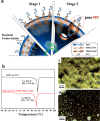CO2-breathing and piercing polymersomes as tunable and reversible nanocarriers
- PMID: 27020003
- PMCID: PMC4810324
- DOI: 10.1038/srep23624
CO2-breathing and piercing polymersomes as tunable and reversible nanocarriers
Abstract
Despite numerous studies on utilizing polymeric vesicles as nanocapsules, fabrication of tunable molecular pathways on transportable vesicle walls remains challenging. Traditional methods for building penetrated channels on vesicular membrane surface often involve regulating the solvent polarity or photo-cross-linking. Herein, we developed a neat, green approach of stimulation by using CO2 gas as "molecular drill" to pierce macroporous structures on the membrane of polymersomes. By simply introducing CO2/N2 gases into the aqueous solution of self-assemblies without accumulating any byproducts, we observed two processes of polymeric shape transformation: "gas breathing" and "gas piercing." Moreover, the pathways in terms of dimension and time were found to be adjustable simply by controlling the CO2 stimulation level for different functional encapsulated molecules in accumulation, transport, and releasing. CO2-breathing and piercing of polymersomes offers a promising functionality to tune nanocapsules for encapsulating and releasing fluorescent dyes and bioactive molecules in living systems and also a unique platform to mimic the structural formation of nucleus pore complex and the breathing process in human beings and animals.
Figures






Similar articles
-
Dendronized multifunctional amphiphilic polymers as efficient nanocarriers for biomedical applications.Macromol Rapid Commun. 2015 Jan;36(2):254-61. doi: 10.1002/marc.201400467. Epub 2014 Nov 14. Macromol Rapid Commun. 2015. PMID: 25400250
-
De novo synthesis and cellular uptake of organic nanocapsules with tunable surface chemistry.Biomacromolecules. 2011 Jun 13;12(6):2327-34. doi: 10.1021/bm200394t. Epub 2011 May 12. Biomacromolecules. 2011. PMID: 21563757
-
Preparation of degradable polymeric nanocapsules from hyperbranched poly (amine ester) grafted nanosilica templates.IET Nanobiotechnol. 2010 Jun;4(2):35-9. doi: 10.1049/iet-nbt.2009.0012. IET Nanobiotechnol. 2010. PMID: 20499996
-
Smart nanocontainers: progress on novel stimuli-responsive polymer vesicles.Macromol Rapid Commun. 2014 Apr;35(8):767-79. doi: 10.1002/marc.201300866. Epub 2014 Feb 13. Macromol Rapid Commun. 2014. PMID: 24522966 Review.
-
Modular Approach for the Design of Smart Polymeric Nanocapsules.Macromol Rapid Commun. 2019 Jan;40(1):e1800577. doi: 10.1002/marc.201800577. Epub 2018 Dec 3. Macromol Rapid Commun. 2019. PMID: 30507023 Review.
Cited by
-
An NIR-triggered drug release and highly efficient photodynamic therapy from PCL/PNIPAm/porphyrin modified graphene oxide nanoparticles with the Janus morphology.RSC Adv. 2019 Dec 2;9(68):39780-39792. doi: 10.1039/c9ra06058h. eCollection 2019 Dec 2. RSC Adv. 2019. PMID: 35541408 Free PMC article.
References
-
- Discher D. E. & Eisenberg A. Polymer vesicles. Science 297, 967–973 (2002). - PubMed
-
- Blanazs A., Armes S. P. & Ryan A. J. Self-assembled block copolymer aggregates: from micelles to vesicles and their biological applications. Macromol. Rapid Commun. 30, 267–277 (2009). - PubMed
-
- Du J. & O’Reilly R. K. Advances and challenges in smart and functional polymer vesicles. Soft Matter 5, 3544–3561 (2009).
-
- Li M. & Keller P. Stimuli-responsive polymer vesicles. Soft Matter 5, 927–937 (2009).
-
- LoPresti C., Lomas H., Massignani M., Smart T. & Battaglia G. Polymersomes: nature inspired nanometer sized compartments. J. Mater. Chem. 19, 3576–3590 (2009).
Publication types
MeSH terms
Substances
LinkOut - more resources
Full Text Sources
Other Literature Sources

